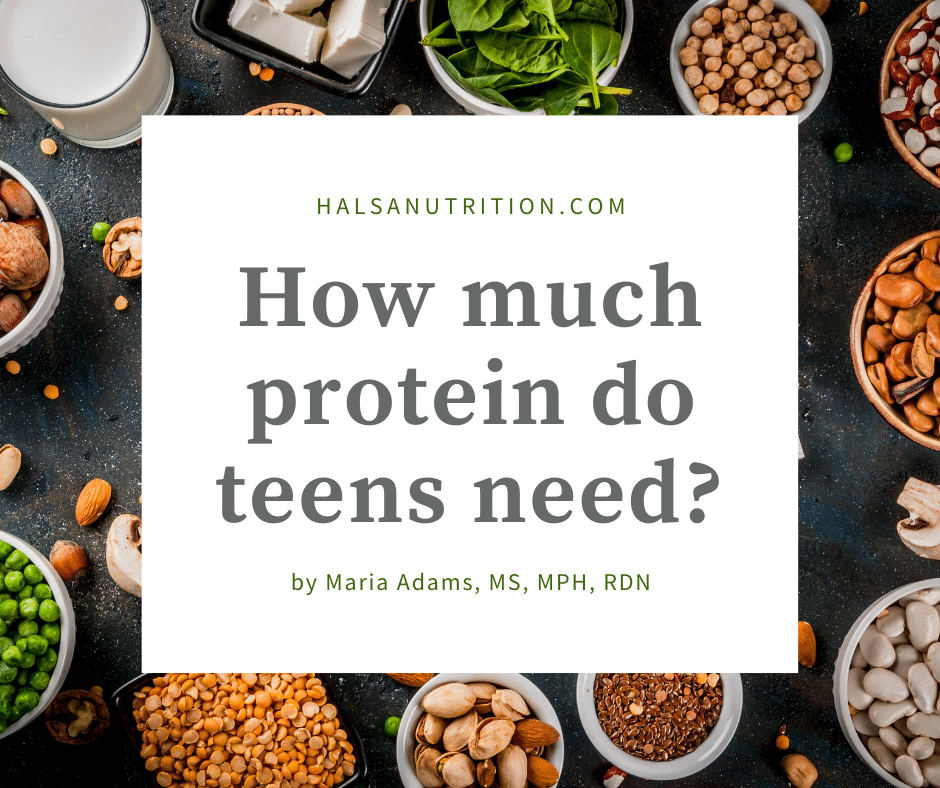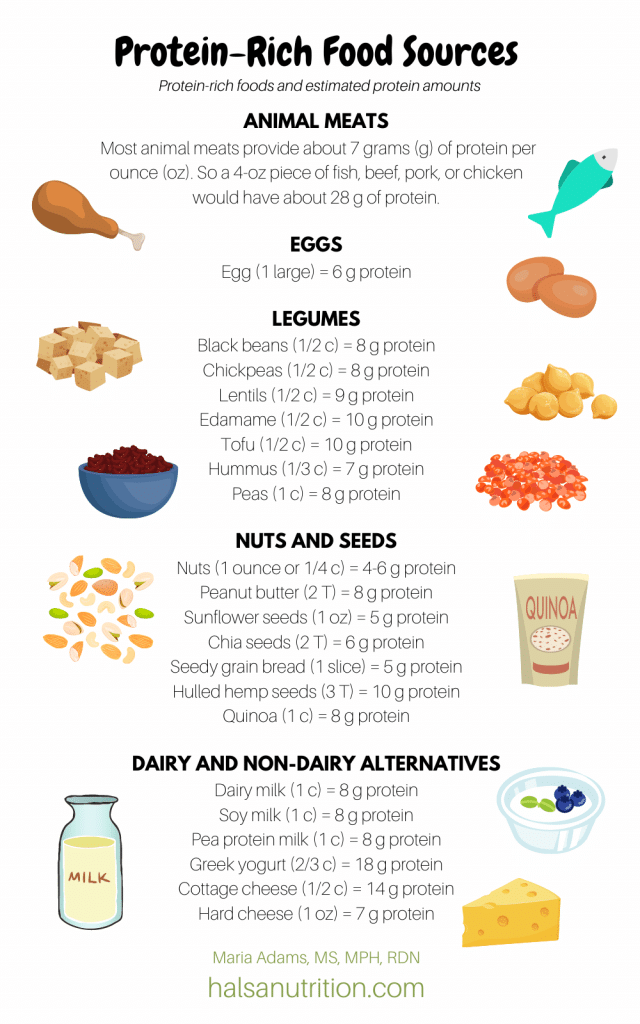
How Much Protein Do Teens Need?
How much protein do teens need? Is your teen getting enough? Read on to find out.
Protein Needs for Teens

Protein is needed daily for growth and repair throughout the body. It’s important to get enough protein at all life stages, including adolescence when kids go through growth spurts, may become more serious with sports, and sometimes develop unbalanced eating habits.
Just how much is needed depends on a variety of factors, including age, height, weight, sex, and activity level.
The RDA (recommended daily allowance) for adults is 0.8 grams of protein per kilogram. For teens and children, it’s slightly higher.
Daily Protein Needs Chart
| Age Group | Protein Need (g/day)* | |
|---|---|---|
| Males | 9-13 | 34 |
| 14-18 | 52 | |
| > 18 | 56 | |
| Females | 9-13 | 34 |
| 14-18 | 46 | |
| > 18 | 46 |
Protein Needs of Athletes
The recommended daily amount goes up to 1.2-1.7 grams/kilogram for athletes, depending on the sport. In general, endurance athletes have needs closer to 1.2 grams/kilogram and strength/power athletes have needs closer to 1.7 grams/kilogram.
To calculate your weight in kilograms (kg) simply divide your weight in pounds by 2.2.
Examples:
- A football player who is also strength training and weighs 150 pounds (68 kg) needs about 116 grams of protein per day. (68 x 1.7 g/kg)
- A cross-country runner who weighs 150 pounds needs about 82 grams of protein per day. (68 kg x 1.2 g/kg)
- A non-athlete who weighs 150 pounds needs closer to 0.8 grams of protein per kilogram per day, so about 54 – 68 grams per day (68 kg x 0.8 g/kg – 1.0 g/kg)
Is My Teen Getting Enough Protein?
You may be surprised to know that most Americans are meeting or even exceeding their recommended protein needs. (Source) Most people who eat a variety of foods and adequate amounts of food have no trouble meeting their protein needs. This means that there is usually no need for expensive protein supplements or shakes.
That said, there are some situations when protein needs may not be met. Teens at risk of falling short on protein needs include those who:
- Adopt a vegan or vegetarian diet without adequate protein sources
- Have high energy needs due to sports or physical activities
- Diet or restrict their food intake
- Are very picky eaters
Certain health conditions and medications can also impact overall energy needs.
One of the most common issues is not the total quantity of protein, but how protein is spread throughout the day. Many people tend to fall short on protein at breakfast and snack time. Ideally, you want to spread it out to include adequate protein in all meals and snacks.
So if you need about 80 grams of protein per day, aim to get about 20 grams at each meal and 10 – 15 grams at each snack.
If you are concerned that you or your child are not getting enough protein consider meeting with a dietitian who can provide a thorough assessment and individualized recommendations.
Note: A more common issue than protein deficiency is iron deficiency, especially among teenage girls and women of childbearing age.
Protein-Rich Food Sources
Here are some protein-rich food sources and specific examples in each category. Keep in mind that the listed protein amounts are estimates and may vary.
Beef, poultry, and seafood
- Animal meats all provide about 7 grams/per ounce (so 3 ounces of fish or beef–about the size of a deck of cards–would provide about 21 grams of protein)
- Egg (1 large) = 6 grams of protein
Legumes
- Black beans (1/2 cup) = 8 grams of protein
- Chickpeas (1/2 cup) = 8 grams
- Lentils (1/2 cup) = 9 grams
- Edamame (1/2 cup) = 10 grams
- Tofu (1/2 cup) = 10 grams
- Hummus (1/3 cup) = 7 grams
- Peas (1 cup) = 8 grams
Nuts and seeds
- Nuts (1 ounce or 1/4 cup) = 4-6 grams
- Peanut butter (2 tablespoons) = 8 grams
- Sunflower seeds (1 ounce) = 5 grams
- Chia seeds (2 tablespoons) = 6 grams
- Hulled hemp seeds (3 tablespoons) = 10 grams
- Quinoa (1 cup) = 8 grams
Dairy and non-dairy alternatives
- 1 cup of milk = 8 grams
- 1 cup of soy milk = 8 grams*
- 2/3 cup of Greek yogurt = 18 grams
- 1/2 cup cottage cheese = 14 grams
- 1 ounce of hard cheese = 7 grams
*Note that except for soy, most non-dairy milk is not a good source of protein, however, certain brands have added protein (e.g., pea protein) to increase total protein.
In addition to the above list, whole-grain bread and cereal also provide 3-5 grams of protein per serving. Most vegetables provide about 2-3 grams of protein per serving.
Sources: John Hopkins Medicine, Today’s Dietitian, Food labels

Building a Balanced Plate
Rather than measuring out protein, focus on eating the amount that is satisfying to you. Start by creating a “balanced” plate or snack when possible.
While a balanced meal will look a little different for everyone, most people find that adding a variety of food groups increases the overall appeal and satisfaction. From a nutritional standpoint, variety is also the best way to get all your nutrients.
According to the USDA’s MyPlate, the main food groups are veggies, fruits, protein, grains, and dairy. Note that it’s possible to get all your nutrient needs without dairy. The Canadian Food Guide does a nice job of illustrating a balanced, optional dairy, food guide.
These guides suggest that protein-rich foods make up about 1/4 of the plate. So whether you are ordering a sandwich, plating up a pasta dinner, or building a salad, aim to make protein-rich foods about 1/4 of the meal.
Take Away Messge
Protein is found in more foods than we realize. In general, focus on providing a variety of foods to your family. There is usually no need to calculate our protein intake. Most teens in the US are getting enough protein and don’t need extra. However, there are situations when teens may be falling short on protein. If you are concerned about your son or daughter’s protein intake consider meeting with a dietitian.
Leave a Reply